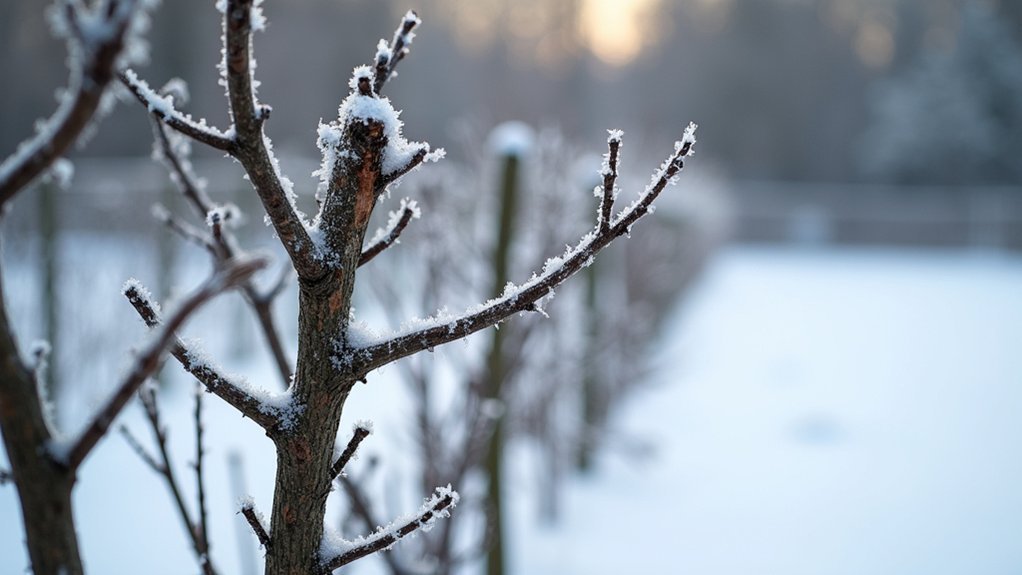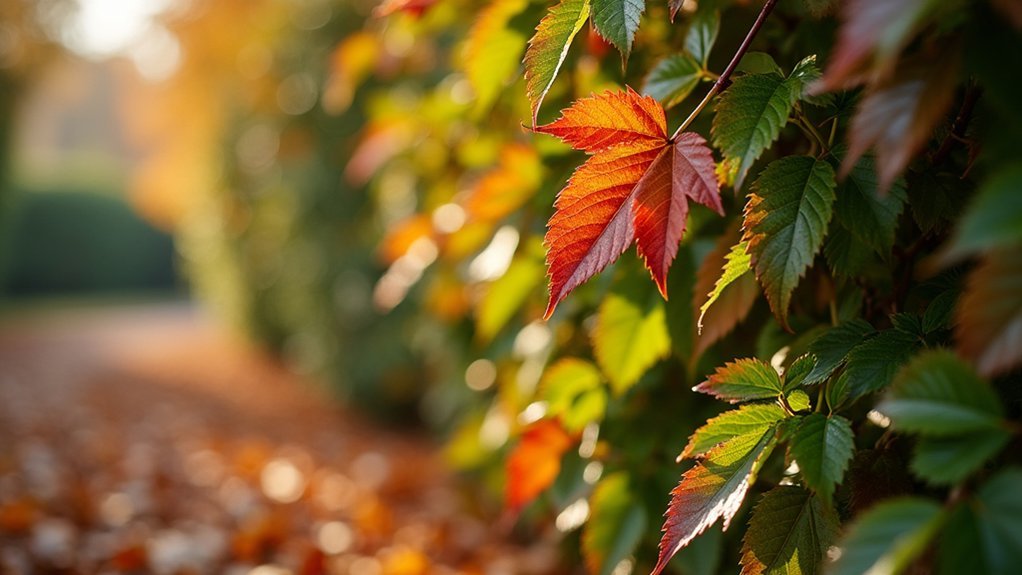Pruning living fences requires seasonal adjustments for ideal health and density. In winter, focus on structural cuts during dormancy. Spring calls for light shaping of new growth while summer maintenance encourages inner light penetration. Fall pruning should be gentle, removing only dead or diseased wood. Always use sharp, clean tools appropriate for each season, and never remove more than 1/3 of growth at once. The right seasonal approach transforms a simple boundary into a thriving ecosystem.
The Winter Reset: Dormant-Season Pruning Fundamentals

When winter blankets your garden in stillness, it offers the perfect opportunity to reset your living fence through strategic pruning. The bare branches reveal your fence’s true structure, making it easier to identify dead, diseased, or damaged limbs that need removal.
During dormancy, plants experience less stress from pruning since they’re metabolically inactive. Make clean cuts at the point of origin or back to strong lateral branches to promote healthy spring growth. Winter is the ideal time to inspect your support structure framework and ensure posts are still secure and wires remain taut for proper training. This dormant-season maintenance enhances structural integrity while supporting biodiversity for birds and insects.
You’ll find additional benefits in winter pruning: reduced risk of disease transmission, better visibility for precise cuts, and preparation for vigorous spring growth.
Plan your pruning on mild winter days, using sharp, clean tools and proper safety equipment to ascertain both your safety and your living fence’s best recovery.
Spring Awakening: Managing New Growth
As your living fence bursts with fresh vigor, spring demands thoughtful management to channel this seasonal energy effectively.
Early-season pruning creates the framework for healthy growth while preventing your living boundary from becoming unruly. Focus on structural shaping now to establish density throughout the growing season. Regular pruning will encourage dense growth patterns in both formal and informal hedges.
Spring is also the perfect time to monitor plant health as conditions warm:
- Check for emerging pests like scale insects and apply treatments before infestations take hold
- Use sharp, clean tools for all pruning to minimize damage and disease transmission
- Incorporate native species when replacing sections to support local pollinators and wildlife
- Apply organic fertilizers if needed to give your hedge the nutrients it needs for robust growth
Summer Maintenance: Light Pruning for Dense Hedges

You’ll find summer’s light pruning sets the stage for how your hedge will grow throughout the season.
Strategic trimming opens pathways for sunlight to reach inner branches, preventing woody centers while encouraging lush, even growth. For formal hedges like boxwood, frequent shearing helps maintain their crisp, defined shapes that create elegant garden boundaries.
Regular maintenance during this period trains your hedge to develop the thick, robust foliage that creates an effective living barrier.
Establishing Growth Patterns
The art of summer pruning forms the cornerstone of establishing healthy growth patterns in living fences. By selectively cutting back new shoots, you’ll help your hedge develop the perfect form while encouraging dense, lateral branching.
When managing your hedge’s growth pattern during summer, focus on:
- Shaping by targeted trimming of fresh extension shoots rather than cutting established branches
- Encouraging branching by pruning shoot tips, which stimulates lateral growth
- Maintaining wider bases than tops to guarantee sunlight reaches all foliage
- Preserving structural integrity by avoiding cuts to main framework branches
Pruning by the end of June after new growth emerges will promote interior fullness and prevent the formation of long, woody arms that reduce vigor.
This gentle approach prevents the need for drastic cutting later and trains your hedge to grow in your desired pattern.
You’ll notice fuller coverage developing by autumn, creating a denser, more resilient living fence for winter.
Shaping Sunlight Access
Summer sunlight must penetrate all levels of your living fence to maintain its density and health through strategic pruning techniques. Employ the “batter cut” approach—keeping the base wider than the top—to allow light to reach lower branches and prevent interior dieback. For best results, prune during early morning hours or on cloudy days to minimize stress on newly exposed foliage. Always wear protective clothing when pruning to prevent skin irritations that can occur with certain hedge trimmings.
| Pruning Timing | Technique | Benefits |
|---|---|---|
| Early June | Top-third thinning | Encourages lower growth |
| Mid-summer | 45° chamfered edges | Prevents snow damage |
| Late August | 1cm growth retention | Maintains vigor |
You’ll need to adapt your approach based on species—conifers tolerate harder summer cuts than flowering varieties. Always verify moist soil before pruning during drought periods, and follow with irrigation to support recovery after midsummer maintenance.
Encouraging Dense Foliage
To achieve lush, verdant living fences, proper summer maintenance becomes essential through strategic light pruning. Early summer is the ideal time to encourage dense foliage by removing just the tips of new growth, which stimulates branching and prevents woody development.
Your hedge’s density greatly depends on your maintenance approach:
- Use hedge shears for precision control, trimming lightly rather than removing large sections at once.
- Apply slow-release fertilizers alongside organic mulch to provide sustained nutritional support.
- Water deeply but infrequently to encourage strong root systems that support thick foliage.
- Monitor for pests and diseases regularly, removing affected branches promptly.
For established hedges, maintain a consistent pruning schedule of twice yearly, adjusting based on your specific hedge species and regional climate conditions. When trimming, always ensure the hedge maintains an upside-down V-shape to allow sunlight to reach all parts of the plant, promoting even, dense growth from top to bottom.
Fall Preparations: Gentle Cuts Before Winter

As trees begin shedding their colorful autumn leaves, you’ll need to approach your living fence with a gentler touch than during other seasons.
Focus on light pruning before the first frost, removing only dead or diseased wood to minimize winter stress.
Limit cuts to 1/3 of plant mass, preserving stored energy reserves. Angle cuts slightly outward to shed moisture and prevent rot. Consider the historical significance of your living fence, as these natural boundaries have provided protection and privacy for hundreds of years.
For deciduous shrubs, wait until leaf drop for better visibility of branch structure. Skip spring-bloomers like lilac to protect next year’s flowers.
After pruning, disinfect tools, remove leaf litter, and apply a balanced organic fertilizer.
Water deeply if soil is dry, then add 3″ of mulch to regulate soil temperature.
Install windbreaks for exposed sections and monitor for damage throughout winter.
Tools of the Trade: Seasonal Equipment Selection
Selecting the right tools for each pruning season makes the difference between a healthy, thriving living fence and one that struggles to recover from poor cuts. Your living fence deserves clean, precise maintenance that varies with the changing seasons.
For effective year-round care, you’ll need:
- Spring arsenal: Hand pruners and loppers for shaping new growth and removing winter damage
- Summer equipment: Long-handled shears and pole pruners to manage height without ladders in the heat
- Fall preparation: Ratcheting loppers to reduce fatigue during heavier pre-winter cutting
- Regional adaptation: Choose tools that match your climate—drought-conscious options for dry areas, protective gear for insect-heavy regions
The telescopic fruit picker with its cutter and bag can be invaluable when your living fence includes fruiting species that need harvesting.
Always maintain sharp, clean blades to prevent disease spread and guarantee your tools have ergonomic handles for comfort during extended pruning sessions.
Training Young Living Fences: First-Year Pruning Strategies

Your first-year pruning choices will establish the foundation for your living fence’s entire lifecycle.
Begin with light, strategic cuts every 4-6 weeks to encourage lateral branching while maintaining a clear structural framework for future growth.
Remember to remove competing shoots that threaten your desired pattern, but never trim more than one-third of the plant’s foliage at once to prevent stress. Since initial maintenance requires more attention, apply a layer of organic mulch after pruning to suppress weeds and retain moisture around developing roots.
Establishing Growth Patterns
The first year of growth establishes the foundation for your living fence’s long-term health and appearance. During this critical period, you’ll need to create patterns that encourage dense, even growth throughout the entire fence line.
Regular pruning is essential—aim for at least twice yearly sessions to maintain your fence’s desired shape and promote fullness.
When you prune, focus on:
- Tip pruning to encourage lateral branching and density
- Removing inner growth that prevents sunlight from reaching lower branches
- Shaping the top and sides to create your desired profile
- Eliminating weak or crossing branches that could cause structural issues
Select plant species that match your climate conditions and maintenance capacity.
Consider incorporating nitrogen-fixing plants like sea buckthorn as alternatives to willows, as they provide soil enrichment while serving as effective barriers.
Disease-resistant varieties will save you significant time and effort while ensuring your living fence thrives for years to come.
Formative Cuts Matter
When a living fence reaches its first year, formative cuts become the defining factor in its long-term structure and density.
Focus on timing: prune in late winter to stimulate vigorous spring growth while minimizing disease risk. Avoid late fall cuts that invite frost damage to tender new growth. Strategic winding of branches horizontally creates a more effective barrier while encouraging lateral growth.
For most deciduous species, plan 2-3 pruning sessions that first year; evergreens typically need only 1-2.
Make heading cuts to encourage lateral branching and denser foliage, while thinning cuts improve airflow. Always cut at a 45° downward angle to prevent water pooling.
Remember the tapered profile rule: maintain a wider base with a 10-15° inward slope toward the top.
This guarantees sunlight reaches lower branches, preventing the bare-bottom syndrome that weakens your living fence’s foundation.
Formal vs. Natural: Tailoring Pruning Styles by Season
Choosing between formal and natural pruning styles depends largely on your garden vision and the seasonal demands of your living fence.
Your garden’s story is told through your pruning choices – formal precision or nature’s casual elegance.
Formal hedges require weekly or bi-weekly trimming during peak growth periods, while natural approaches need minimal intervention.
For formal living fences, time your pruning strategically:
- Deciduous varieties benefit from late winter structural pruning followed by shape maintenance after spring growth.
- Conifers respond best to mid-summer pruning to control growth and maintain precise forms.
- Young plants need regular top trimming to encourage dense lateral growth.
- Always use sharp, clean tools to prevent disease spread between plants.
Natural styles support greater biodiversity while requiring less maintenance, making them ideal if you’re seeking wildlife-friendly boundaries with seasonal interest and ecological value. Options like Winterberry provide bright red berries that add visual interest while attracting local wildlife to your garden ecosystem.
Weather Impact: Adjusting Pruning Schedules to Climate

Your living fence’s health depends on adapting pruning schedules to your local weather patterns and seasonal shifts.
You’ll need to modify timing and techniques based on temperature extremes, precipitation levels, and growth cycles specific to your region. During summer, it’s important to trim vegetation regularly to prevent overgrown plants and vines from causing damage to your living fence structure.
Consider both immediate weather conditions and long-term climate trends when planning maintenance to prevent stress and encourage resilient growth.
Weather Impact Considerations
Although many gardeners follow traditional pruning calendars, local climate conditions should ultimately dictate your living fence maintenance schedule. Weather patterns greatly influence both your fence’s durability and plant health, requiring you to adapt your approach throughout the year.
Before planning your next pruning session, consider these critical weather factors:
- Heavy precipitation can erode soil around roots and increase rot risk in wooden elements—inspect thoroughly after storms.
- Temperature fluctuations cause expansion and contraction in materials, potentially leading to warping or structural issues.
- Strong winds threaten weak branches—prune preventatively before windy seasons arrive.
- Snowfall adds weight to branches, making preventative pruning essential in regions with heavy winter precipitation.
- Summer heat can cause wood fences to dry out and crack, requiring additional maintenance and possibly more frequent watering for living fences.
Being proactive with weather-informed maintenance will extend your living fence’s lifespan while ensuring it remains both functional and attractive.
Regional Climate Adaptations
Different regions require specialized pruning approaches that align with local climate patterns.
In cold climates, complete major pruning before extreme cold sets in, and focus on frost-resistant species like inkberry holly. Regular removal of cracked or ice-damaged branches prevents disease vulnerability in living fences. Use open-center techniques to prevent snow load damage.
For tropical environments, prune productive species like Erythrina every 4-6 months, completing heavy work before monsoon seasons to prevent fungal infections.
Temperate zones benefit from post-frost pruning timed with sap flow, while staggering cuts on mixed hedges preserves pollinator resources.
In arid regions, prune during cool morning hours after irrigation, maintaining wider bases to shade root zones.
Mediterranean climates require fire-conscious pruning before summer drought peaks, often using two-stage systems with winter shaping followed by post-rain maintenance.
Rejuvenation Techniques for Aging Barriers
Living fences require thoughtful rejuvenation as they age to maintain both their beauty and functionality. As your barrier matures, you’ll need strategic approaches across all seasons to guarantee its continued vigor and structural integrity.
A mature living fence demands seasonal attention and strategic care to preserve its aesthetic appeal and boundary-defining purpose.
During winter inspections, identify weak spots while plants are dormant, then apply a 2-4 inch mulch layer to protect roots.
In spring, focus on revitalizing through targeted pruning and sealing any gaps that compromise privacy.
For thorough rejuvenation, consider:
- Mixing evergreen and deciduous species to enhance biodiversity and resilience
- Implementing creative pruning techniques to restore structure and form
- Adding disease-resistant varieties like Ilex glabra Strongbox® to replace vulnerable sections
- Applying seasonal maintenance strategies—winter protection, spring replanting, summer growth control, and autumn soil conditioning
Beyond the Cut: Post-Pruning Care Throughout the Year
Proper care after pruning determines whether your living fence will thrive or merely survive. Maintain consistent moisture especially during the first few weeks after cutting, while applying mulch to conserve water and suppress weeds.
Throughout seasons, adjust your approach accordingly. In spring, early pruning promotes vigorous new growth.
Summer requires vigilant monitoring for drought stress and pests.
Fall calls for light maintenance before winter sets in, while protective coverings may be necessary during extreme cold months.
Watch for signs of post-pruning stress—yellowing leaves or branch dieback—and respond quickly.
Most living fences require 2-5 years to fully establish, but your consistent care builds resilience against environmental challenges.
Remember that good airflow prevents fungal issues, so prune to maintain adequate spacing.
Species-Specific Seasonal Considerations
While all living fences benefit from regular maintenance, each species responds uniquely to seasonal changes and requires tailored pruning approaches. Understanding these differences will help you maintain a healthier, more attractive living boundary throughout the year.
Tailored seasonal maintenance is the secret to vibrant living fences that thrive year after year.
- Lilacs thrive with early spring pruning to control excessive growth and enhance blooming when warmer weather arrives.
- Deciduous species require late winter structural pruning during dormancy, followed by shape maintenance after spring growth spurts.
- Conifers perform best with mid-summer pruning focusing only on current year’s growth to prevent damage to older wood.
- Cerythrina benefits from autumn pruning to prepare for robust spring growth, unlike most deciduous species that need only light pruning in fall.
Remember to adjust your pruning schedule according to your specific plant varieties and local climate conditions.
Creating Wildlife Corridors While Maintaining Boundaries
A thoughtfully designed living fence can serve dual purposes by maintaining clear property boundaries while creating essential corridors for local wildlife.
When planning your fence, identify existing migration paths and incorporate features like “elk jumps” or strategic gaps that allow animals to cross safely without compromising security.
Make corridors wide enough for comfortable passage but narrow enough that wildlife feels protected. Include covered sections where smaller creatures can travel securely alongside periodic openings for larger animals.
Regular maintenance guarantees these passages remain functional—prune carefully to maintain structure without disrupting the habitat your fence provides.
Consider integrating your living fence into broader landscape strategies, creating connections between fragmented habitats.
This approach not only supports biodiversity but also fulfills legal requirements in areas where wildlife-friendly fencing is mandated.
Signs of Stress: When to Skip a Seasonal Pruning
Recognizing signs of stress in your living fence can determine whether you should skip a seasonal pruning. While regular maintenance is important, forcing pruning on already stressed plants can cause permanent damage or even death.
Watch for these indicators that your living fence needs recovery rather than cutting:
- Yellowing or browning leaves outside normal seasonal changes
- Significant dieback of multiple branches, especially during growing season
- New growth that appears stunted, malformed, or sparse
- Visible pest infestations or fungal diseases spreading across plants
If you notice these symptoms, focus on hydration, proper fertilization, and pest management instead of pruning.
Allow stressed plants a full growth cycle to recover before resuming your regular pruning schedule. You’ll create a healthier fence that will thrive for years.
Frequently Asked Questions
Can I Prune During Flowering to Encourage Repeat Blooms?
Yes, you can prune during flowering, but it’s best to wait until after a bloom cycle. Deadheading spent flowers specifically encourages repeat blooms without stressing the plant like heavy pruning would.
How Do Living Fences Impact Property Values Compared to Traditional Fences?
Living fences often boost your property value through enhanced aesthetics and privacy, while traditional fences offer immediate security. Your return varies by market preferences, maintenance commitment, and whether buyers value eco-friendly landscaping or convenience.
Are There Smartphone Apps to Help Track Pruning Schedules?
You can track pruning schedules with gardening apps like Seedtime or Planter, or adapt productivity tools like Routine or TrackingTime. For simpler needs, standard calendar apps with reminders work effectively too.
Can Pruning Waste Be Composted or Repurposed Effectively?
Yes, you can compost or repurpose pruning waste effectively. Shred smaller branches for faster decomposition, use larger ones for mulch, and incorporate fall leaves to balance your compost pile’s carbon-nitrogen ratio.
Do Living Fences Require Special Permits in Urban Areas?
In Columbus, you’ll need permits for living fences over 6 feet tall. Contact the Zoning Office at 614-645-8637 for guidance. Corner lots have specific visibility requirements, and height restrictions vary between municipalities like Dublin’s 4-foot limit.
In Summary
Living fences require your attention through all four seasons. You’ll find that adapting your pruning approach to each season’s unique demands creates healthier boundaries that benefit both your landscape and local wildlife. Remember, it’s not just about cutting—it’s about cultivating living architecture. Trust your observations, respect each plant’s natural rhythm, and you’ll develop living fences that thrive beautifully year after year.





Leave a Reply